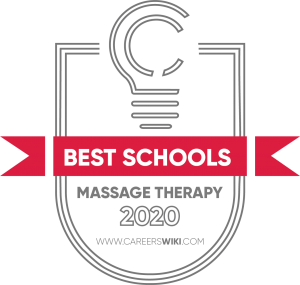…
There are 17 massage therapy schools in Ohio, including public and private institutions.
On most campuses, students pursue certificates that take between less than a year and 15 months to complete. A few schools award two-year associate degrees. Curricula involve classes, labs, and clinical experiences.
Ohio massage therapists do not make quite as much money as their contemporaries in most other states, but the employment opportunities are expanding rapidly. There will be about 460 job openings every year during the decade ending in 2026, according to federal labor officials.
You might also be interested in viewing the full list of best massage therapy schools in the U.S.

This government agency oversees many healthcare professions, including massage therapy. It licenses practitioners, ensuring that they meet standards of education, training, competence, and ethics. The board defines criteria for the safe practice of massage therapy.
Another duty is to approve schools, based on minimum curriculum requirements. The board monitors postsecondary education programs and renews certificates of good standing each year. Schools that fail to comply with regulations may face program suspension, probation, or the loss of their certificates.
The board investigates complaints regarding alleged violations of state public health and safety standards. Disciplinary action ranges from fines to license suspensions or revocations.
The governor appoints 12 board members to five-year terms. Nine of the officials are physicians and three represent the public.
To become a massage therapist in Ohio, a student must first earn either a high school diploma or a GED. Taking college-level health, science, and business classes may be beneficial when applying for admission to an MT school.
It is crucial to enroll in an accredited postsecondary institution that has received authorization from one of the following Ohio government entities: the Board of Regents, the Board of Career Colleges and Schools, or the Department of Education.
The state requires MT programs to feature 750 or more clock hours of instruction and training. This is to include 325 hours of courses in anatomy, physiology, and pathology; 325 hours of theory and practical work; 25 hours of business and law; and 25 hours of ethics.
Each student must administer at least one massage to a licensed therapist.
Some programs exceed the 750-hour minimum. They may provide classes in a wider variety of massage techniques, or give students more hands-on experience in clinical settings.
Upon graduation, the next step is to apply to the state medical board for licensure. One of the board’s requirements is that an applicant post an acceptable score on the Massage and Bodywork Licensing Exam (MBLEx).
Students apply online to the Federation of State Massage Therapy Boards for authorization to take the test. This entails a fee of about $200. The multiple-choice, 100-question, computer-based exam is administered at Pearson VUE testing centers. The company reports results to the state medical board.
MTs are required to obtain license renewals and receive continuing education every second year.
We selected the schools below based on the programs that they offer, accreditation, student population, graduation rate and reputation.
View our Ranking Methodology to learn more about how we rank schools.

NA
85
This private school in Perrysburg was previously known as the Healing Arts Institute.
The massage therapy program consists of 750 hours that students can complete in 10.5 to 12 months. There are four semesters, with breaks in between. The daytime program involves eight hours of classes on Tuesdays and Fridays. An option is to attend four hours of evening classes Monday through Thursday. The curriculum, which covers state requirements, includes 100 hours working in a student clinic and 14 hours of field experience.
There is a Body Therapy store on campus, and the school provides continuing education classes.
59%
39
This non-profit nursing school in Huber Heights was formerly known as the Ohio Academy of Hypnotherapy and the Ohio Academy of Holistic Health.
The four-quarter, 58-credit massage therapy certificate program features 400 clock hours of classes, 200 hours of lab work, and 120 hours in clinical settings. The curriculum is designed for “those who want to focus on clinical and rehabilitative approaches with a holistic understanding of healing.”
In addition to providing the state-required coursework, the program teaches aromatherapy, the use of non-directive imagery, and how to start a massage therapy practice.
61%
92
This private technical school offers more than 30 career programs on campuses in three states. It was founded in Kentucky in 1963 as Owensboro Business College.
Students pursuing massage therapy certificates receive 900 clock hours of instruction, which take 12 months of full-time classes to complete. The curriculum complies with state standards; and teaches Swedish, therapeutic, sports, prenatal, and hot stone massage.
Among the other courses are Hydrotherapy, Reflexology, and Orthopedic Massage Applications. Students administer massages to the public at on-campus clinic.
63%
109
A family-owned business in operation for about a half-century, RSBC offers a massage therapy program on its Youngstown/Boardman Area Campus.
The curriculum provides 385 clock hours of classes and 515 hours of clinical practice. A student clinic serves real clients. The program teaches these massage techniques: Swedish, chair, sports, deep tissue, pregnancy, infant, Oriental, toning facial, and relaxation facial. Students also learn Shiatsu, hydrotherapy, reflexology, aromatherapy, and herbology.
The part-time program lasts about a year. Classes start every month. The school has career services to help graduates secure employment.
79%
127
This for-profit school in Kent offers six career tracks, including a diploma program in massage therapy.
The curriculum consists of 900 clock hours, 168 of which involve working in a student massage clinic. Classes take place two days per week for 14 months. Programs begin in February, May, August, and November.
The school touts is small class sizes, affordable tuition, free tutoring, and career services. Students learn how to write resumes, create professional portfolios, and search for jobs. They take part in mock interviews to sharpen their skills.
80%
244
A public high school in Mount Vernon houses this adult education center, which offers a 15-month massage therapy program.
The curriculum involves 817 clock hours, including 689 hours of classes and labs in ethics, anatomy, physiology, business, and law. There are an additional 103 “work-based” hours at clinics and events. Students learn Swedish, chair, sports, and special population massage; as well as hydrotherapy and spa treatments.
Classes are held on Tuesday and Thursday evenings, with one Saturday class twice per month. Ninety-seven percent of graduates pass the licensing exam.
75%
267
This small, public school in Milan provides occupational training in a number of fields. The 926-clock-hour massage therapy program lasts 12 months (four evenings per week plus every other Saturday). An 18-month part-time option is available.
In addition to the state-mandated courses, students take Introduction to Computers, Pharmacology, Disease Identification, and Myofascial Release. They learn Swedish and chair massage techniques.
Hands-on learning takes place inside and outside the classroom. Students give massages to the public at community outreach events. The program has a 100 percent acceptance rate, but there are limited slots.
86%
249
This network of private institutes operates campuses in Cincinnati’s Cornell Business Park, Cleveland’s Middleburg Town Square, Dayton’s Arbor Shopping Center, and Dayton’s Apollo Career Center; and on Blazer Parkway in Columbus.
The 1,122-clock-hour, 39-credit program entails 43 weeks of day classes or 58 weeks of evening classes. The curriculum includes 130.5 hours of classes in “mind/body relationship, business building, and personal and professional development.”
Students administer 75 one-hour massages at an on-campus clinic, give three massages to instructors, and receive four massages from licensed therapists. They must take a CPR class and earn certification before graduating.
85%
258
High school and adult learners here choose from among more than 20 career programs. The small, public school has a massage therapy program on its Circleville campus.
The 900-clock-hour curriculum entails 714 hours of classes, 150 hours of labs, and 36 hours in a practicum. More than 300 hours are devoted to teaching Swedish massage and other modalities. In addition to state-required courses, students take Myology, Business Management, and CPR/First Aid. The program involves classes three days per week for 36 weeks.
The school maintains an open admissions policy, accepting students on a first-come first-served basis.
75%
316
Massage therapy is one of 15 occupational programs at this public school’s adult education center in Newark.
The 835-hour program takes one year to complete. It covers the basic coursework, as well as neuromuscular therapy, reflexology, hydrotherapy, and spa applications. Students learn numerous massage techniques, such as Swedish, seated, sports, special populations, deep tissue, and hot stone. Classes teach gliding, kneading, friction, compression, tapotement, vibration, stretching, and joint movement.
The curriculum includes 180 hours administering massages to the public in The Zen Garden, a student clinic. Most of the faculty members are working massage professionals.
77%
425
This private school in Columbus began in 1990 as Massage Away Inc. It has since expanded to also offer nursing and acupuncture programs. The institute prides itself on the diversity of its student body.
AIAM has the longest-running massage therapy program in central Ohio. The 750-hour, four-quarter curriculum lasts 12 months. Students attend classes on Fridays and Saturdays, and receive 100 hours of clinical experience. They learn Swedish and advanced massage techniques.
An Asian Bodywork class teaches traditional Chinese medicine, yin-yang theory, five-element theory, Qi, essence and Shen, Zang Fu organs, and other Asian theories.
30%
1797
This public school in Marietta was formerly called Washington Technical College. It awards one-year certificates and two-year associate of applied science degrees in massage therapy.
The 40-credit certificate curriculum features state-required coursework, as well as First Aid & Personal Safety, Myology, and Orthopedic Assessment and Documentation. Students learn to give massages to infants, children, working adults, pregnant women, seniors, the unhealthy, and the terminally ill.
To earn the associate of health and wellness degree, a student must also take at least 30 hours of general education classes in composition, math, social and behavioral sciences, arts and humanities, and natural sciences.
19%
11654
A public institution in North Canton, SSC boasts a 95 percent employment rate for graduates.
The school offers two massage therapy programs: a one-year certificate and a two-year associate of technical studies degree. The certificate curriculum, which students may complete full or part time, consists of 750 hours and 41 credits. It complies with state standards and includes additional classes like Psychological Aspects of Therapy.
The associate in applied science degree lasts five semesters and includes general education coursework. A sports massage therapy certificate is also available. Among the 23-credit program’s classes are Nutrition for Health and Anatomy of Exercise.
19%
23440
This public school is the oldest and largest community college in Ohio. It awards certificates and associate degrees in massage therapy.
The one-year, 34-credit certificate of proficiency involves three semesters. In addition to state-mandated courses, students take College Composition. Placement testing determines whether English or math classes are necessary. The certificate is transferable to an associate in applied science degree.
The four-semester, 16-month, 62-credit AAS includes the certificate coursework plus General Psychology, Mathematical Explorations, Small Business Management, Life Span Development, and independent study and research. Enrollees in both programs practice their skills in a student clinic.
23%
27343
This school, where 98 percent of graduates pass the licensing exam, provides three massage therapy certificates.
The basic program contains the required courses, as well as Human Biology, Responding to Emergencies, Myology, and Interpersonal Skills. Electives are
Hot Stone Massage, Trigger Point Therapy, Sports Massage, Aromatherapy Therapy, Spa Services, Oncology Massage, and Special Topics in Massage Therapy.
The advanced techniques program has the same curriculum, with an emphasis on specializations that a student can pursue. The massage therapy / entrepreneurship program requires additional courses in Composition, Bookkeeping, Mathematical Concepts for Business, and Marketing Principles; plus an arts and humanities class.
$20
$36,700
28%
The average pay for an Ohio practitioner is an annual salary of nearly $36,700 or an hourly wage of more than $17.60, according to the U.S. Bureau of Labor Statistics (BLS). That is less than the national median of over $41,400 a year or about $20 per hour.
The state’s top 10 percent make around $63,400 or $30.50, not as much as the approximately $78,300 or $37.60 nationwide. The bottom 10 percent receive about $19,000 or $9.30 in Ohio, and over $21,300 or around $10.25 nationally.
Positions for Ohio massage therapists totaled 3,180 in 2016. The BLS predicts the number will reach 4,080 by 2026. That would be a job-growth rate of 28 percent, faster than the projected national median of 26 percent.
Sources: U.S. Bureau of Labor Statistics, CareerOneStop

LIMITED TIME DEAL